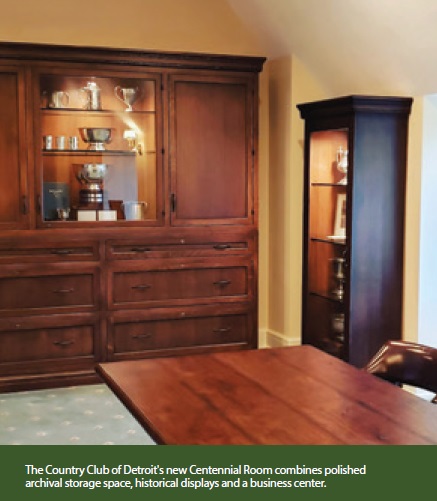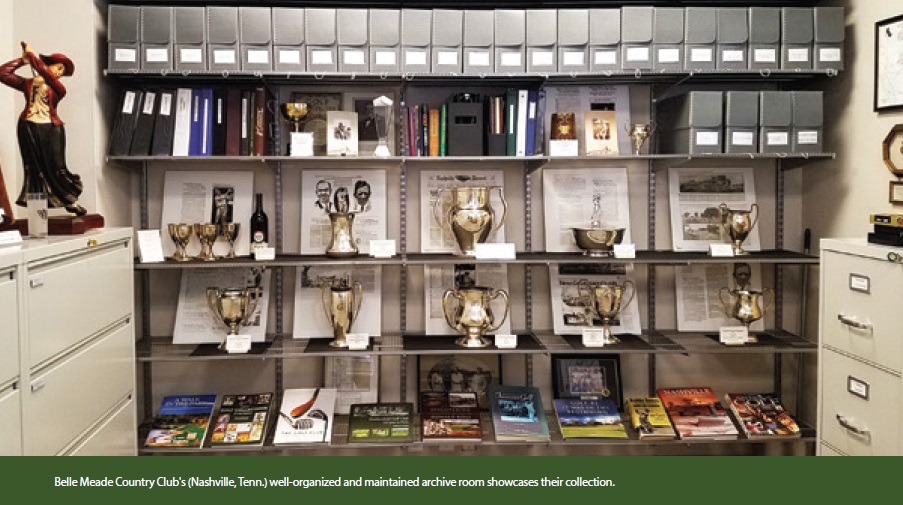I have worked with clubs and club history as a curator for 33 years and have gained many valuable lessons along the way that might prove useful. I intend to give these trade secrets away in one sweeping shot in this article. Perhaps this is not the best career move on my part, but I’ve had a good run.
All clubs seem challenged by the same issues, regardless of championship pedigree. For the most part, you are all essentially in the same boat. You have inadequate storage; you aren’t sure what’s historically significant or what should be tossed; you’re unsure how to properly keep or display your historical assets; you may not even know what elements of your history make you special. You are unaware of the value of your collection and therefore, it may not be adequately insured. Your staff is too busy to handle ongoing archival projects, and your members might not care about history anyway. I could go on, but you get the idea.
History can become a valuable asset, and I can provide some hope and direction. Examples of success will be used throughout, but don’t be intimidated by the high-profile club—the basic message will work on any level for just about anyone.
For many clubs, history is a vague concept with few concrete benefits. How can you take a memory and turn it into a series of proactive, tangible initiatives? The first step is to understand that these ethereal memories relate to actual people and events that produced a marker in time deserving of recognition. With enough of these milestones strung together, you can represent club evolution and help members understand they are part of something special. I call it a continuum of club history that generations of members have passed forward.
Define Your “Chapters”
It may seem simple, but clubs often fail to identify the key characteristics that make them unique. I worked with a club whose leaders didn’t know they hosted a USGA championship. Other seemingly simple facts might be overlooked but are actually significant. For example, another club discovered they had a tee-to-green underground watering system in place in the 1890s—that’s bragworthy!
Most club stories are filled with people who made their mark, famous guests, important championships, sporting traditions and prominent clubhouse or golf course architects. You may also have a unique tie to regional history, a formidable founding history, lasting social traditions, or traumatic fires, floods or natural disasters. Task No. 1 is to identify your key chapters—the chapters of your club’s history—and place them into a chronology.
Round up Assets
Now that you know the chapters of your history, what do you have to represent them? For this, collect all relative artifacts, images, newspaper clippings, artwork and ephemera. These items might be on display in the clubhouse or perhaps in a box in some corner of the basement, but an inventory should be made of their existence. No stone should be unturned in this process. I once discovered an entire steamer trunk of founding documents and property deeds sitting among holiday decorations in attic storage. In fact, not a site visit passes without a discovery of some importance in obscure spots. If you have two old, color golf
lithographs by Douglas Adams, there is likely a third print somewhere else in the building.
A final note on your treasure hunt: Superintendents are pack rats who hoard important early routings and maps for their reference, and the head pro thinks something in the office or pro shop belongs to them when it is actually club property. One pro left his post and took with him all original hole routings and diagrams because “they were mine.” Sure they were.
Find an Archive Room

This found material needs to go somewhere. I know you don’t have storage but in truth, the storage you have is likely disorganized. When you learn the surprising value of your collection, it will be easier to set aside a large closet or spare room somewhere dedicated specifically to your historic assets. This is key.
Merion Golf Club’s archive, in Ardmore, Pa., serves as the model, developed 20 years ago from a collection of mixed assets stored in cardboard boxes above the pro shop. From these humble beginnings, they committed to the process and found a great space for the archive to grow.
Understand that stored materials will not just sit in one place and do nothing; they will become activated in many positive ways. The collection will continue to grow in scope and value, so make sure to plan for this eventuality. Make best efforts to pick a spot that is free from overhead pipes, windows or secondary access, or fluctuations in temperature. The archive room will make a statement to membership that the club’s history is a priority. An archive room can also be envisioned as a spacious business center with hardwood cabinetry, display cases for visible storage and comfortable furniture—just ask the Country Club of Detroit.
Document the Collection
Enter all your artifacts into a database. This can be as simple as a spreadsheet or as complex as a custom software program. It is
vital to document exactly what you have. Create customized fields in the form to include accession number, media type, location, value, year and condition. You can also create specialized fields that link items to one of your history chapters, key club events, sports and types of recreation, past presidents, prominent individuals, etc. This diversity is the main reason a club database is completely different than a standard museum or library database. Databases are more useful and easier to sort when there are plenty of specialized fields.
When your archival database is complete, insure the collection. A word of caution: Don’t make the values known to a wide audience. Thieves removed one club’s archive room door by pulling the hinge pins the day after values were mistakenly circulated.
Create Order
The ideal time to improve the storage of the collection is while you’re documenting it. The main component to this step is to order and implement archival supplies, such as acid-free files, folders and boxes. This isn’t expensive, so set up an account with an archival supply company.
Archives are best arranged into useful sub-collections like photographs, clippings, administrative files, ephemera, multi-media, artwork, three-dimensional objects, flat files, decorative arts, equipment and clothing. This is important because each type of material requires somewhat different storage, making it more effective to keep similar items together. Include a workspace, computer and scanner.
I once worked with a club that was founded in the 1880s and had all their stuff piled in a room so densely that the door wouldn’t open. The project seemed insurmountable to the club, which led to years of inaction. Once started, the organization only took four days.

Form a Committee
Every club has a person who is far too interested in club history. Almost every club historian I have ever worked with was selfappointed. That’s OK, because that person is probably the only one committed enough to devote significant hours for free.
A History or Heritage Committee of no more than five people, including a board liaison, should be formed. These individuals will safeguard the collection, oversee archival initiatives and promote the club’s heritage. They will need a mission statement along with short-term and long-range goals.
Create firm policies and procedures that relate to the use and care of the collection. Assign an annual budget for history work, usually to include framing, archival supplies, conservation, equipment or special projects. The Oakland Hills Country Club Heritage Committee
hands out research and writing assignments for publication in the newsletter. These wonderful history articles are then periodically collected and bound into an anthology for the members.
Upgrade Condition
The “condition” field in your database should note all items that are deteriorating and in need of conservation. Make a list of these items and prioritize them for annual preservation projects. Ask yourself what you can least afford to lose. Start with founding documents, club minutes or other materials with real value to the club.
In our digital world, it is urgent to scan anything that isn’t moving. Photos, clippings, club minute books and ephemera should be top targets for scanning. It’s also the ideal way to engage the committee. I have numerous clients scanning their minute books with optical character recognition software (OCR) so the information is preserved and fully searchable.
Find a flatbed scanner with 11 x 17-inch capability for in-house jobs and identify a reputable firm to outsource larger bulk scanning projects. Scans are better for display because the images can be manipulated, improved and re-sized. They also pose less risk of theft or damage.
Activate Your History
There are many ways to get your collection working. Start by displaying your chapters throughout the clubhouse. Pick a surefire winner for your first project to gather momentum. Refrain from mixing themes or shoving everything into one space. A walking tour of the clubhouse should allow for a full presentation of your story. Include relevant text in a consistent location so the “turtles” can get their information while the “rabbits” look at the big pretty pictures. Understand that the work put into developing displays is essentially the same work put into developing website content, newsletter features or a club history publication. The images, artifacts and storyline should be put to multiple use.
Often, a club unveiling their multi-million-dollar clubhouse renovation will receive kudos for the new displays rather than the selection of paint, carpet, drapes, furniture, windows, etc. Great exhibits can be powerful.
Enact Special Programs
Clubs should create special initiatives that benefit their history. This can be done in many great ways, such as a trophy acquisition campaign to raise enough funds to replicate or acquire representative trophies. Other clubs have achieved state and national historic designation that allowed for the creation of a tax-exempt foundation. Still other clubs have created an oral history program to interview longstanding members for their memories.
Surely, you have an anniversary of some sort on the horizon that will require special events to celebrate history. You can embed a cornerstone, hold a speaker series, commission a portrait or bronze, place cast-bronze markers on the grounds or course to commemorate milestone events, or hold a silent auction of old clubhouse decorations that will otherwise never again see the light of day. One club created an Acoustiguide audio tour for the clubhouse that was narrated by Jim Nantz. The possibilities are endless if you’ve prepared the collection for activity.
More Secrets
Take every precaution to secure your collections and displays with locks, magnetic contact and glass-break alarms or closed-circuit television. One club had its silver stolen by a guy who came back the next week for the trophies he missed. Don’t hang anything valuable near an exit door and make sure important items are behind glass, not sitting loose on an open bookshelf. Start a reading library but not a lending library. Be vigilant. Search for and acquire items that fill gaps in your history. Accept donations with no attachments of perceived use, and credit the donor. Educate the staff on the club’s history; they are the main point of contact for members and guests. Include a history or archive section in your newsletter. Don’t be intimidated by history work and remember that most successful programs make lasting progress over a five-year period.
Final Reminders
I’m sure I’ve missed a few things, but here is a helpful rundown of reminders to keep you on track:
- Define the characteristics that make your club unique.
- Build a proper archival collection that reflects your chapters.
- Activate the collection through displays and special programs.
You can do this.


